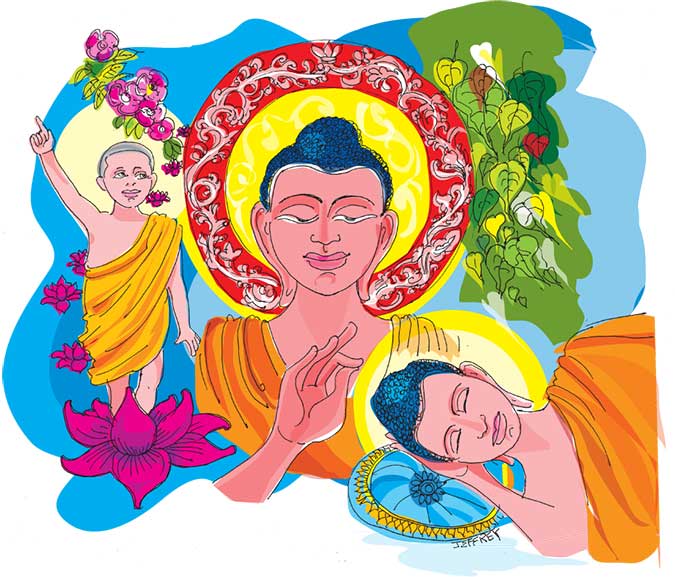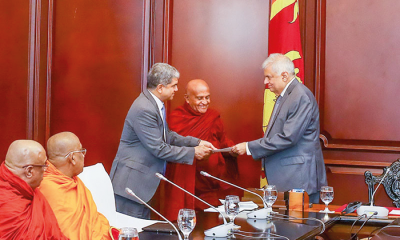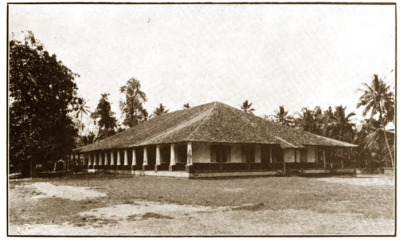Features
Dependent origination (paticcasamuppada) and pragmatism in Buddhism

By Dr. Justuce Chandradasa Nanayakkara
Wesak day marks the three important events in the Buddha’s life -his birth, Enlightenment and his passing away. Since the advent of Buddhism millions of people across the world have been inspired by the Buddha’s life and his teachings
For more than two centuries, Buddhism has been a powerful, religious, political, and social force, not only in the country of its origin but in many other parts of the world. Buddhism has stood the test of time, remain relevant even in today’s fast paced materialistic world and it is believed that appeal of Buddhism will continue far into the future.
Buddhism is essentially practical and pragmatic in its orientation as it stresses the importance of practice over theory. The Buddha’s teachings emphasise on learning based on one’s observations and perception and believe that knowledge is not complete unless it is backed by experience. It teaches us to how to lead a virtuous ethical life, while facing the inevitable ups and downs of our lives. His teachings propose practical solutions to human problems. The Buddha is essentially a pragmatic empiricist.
The Buddha was a unique religious leader who encouraged reasoned, critical assessment of his teaching. This is borne out by his discourse to Kalamas calling for free vigorous investigation into the truths Buddha himself propounded. This discourse counters dogmatic assertions and blind faith prevalent at the time. Addressing Kalamas, the Buddha declared, “Come O Kalama’s, do not accept anything on mere hearsay. Do not accept anything by mere tradition. Do not accept anything on account of rumours. Do not accept anything just because it accords with your scriptures. Do not accept anything by mere inference. Do not accept anything by merely considering the appearances. Do not accept anything merely because it accords with your preconceived notions. Do not accept anything merely because it seems acceptable. Do not accept anything that the ascetic is respected by us. But when you know for yourselves these things are moral, these things are blameless, these things are praised by the wise these things when performed and undertaken, and conduce to ruin and sorrow then indeed do you reject them. “When you know for yourselves these things are moral, these things are blameless, these things are praised by the wise, these things when performed and undertaken conduce to wellbeing and happiness, then do you live and act according“. (Narada Thero).
The Buddha was a human being. He was born and lived as a human being but he was an extraordinary being who never arrogated to himself divinity.
Buddhism provides human beings with a practical and achievable path that leads to the alleviation of suffering or misery human beings experience in their day today life. Buddhism offers a notable advantage in reducing stress and anxiety which are increasingly common issues in our competitive fast-paced high stressed lives.
The Buddha’s teachings are so vast and extensive and it has shown remarkable ability to adapt itself to different circumstances and situations.so that people in all kinds of situations and predicaments can find some kind of solace and consolation by incorporating its basic tenets in their lives.
Unlike most western religions, Buddhism does not expect you to accept the authority of a supernatural being for one’s deliverance. Any external supernatural agency plays no part whatever in the moulding of the character of a Buddhist. Happiness and misery are the inevitable results of one’s own actions. Exhorting his disciples at his Parinibbana the Buddha made the following declaration which holds true even at present “Be ye islands unto yourselves, be ye a refuge unto yourselves, seek not for refuge in others.”
An important element in Buddhism is the efficacy of Buddhist methodology, an actual path that leads to the alleviation of suffering or unsatisfactoriness in the world. Buddhism provides us strategies for navigating daily challenges with equanimity, fortitude and wisdom. Adherence to Buddhist principles makes a person more resilient, composed and eventually a more fulfilled individual.
The law of dependent origination is one of the central teachings of the Buddha. Dependent Origination has been rendered into English in various forms. Some call it “dependence arising”, “causal conditioning”, “causal genesis” and conditioned genesis. In Pali this principle is designated as Patticca Samuppadha. Dependent Origination is a complex and profound concept, as a teaching it is difficult to clearly comprehend and it is subject to a variety of explanations and interpretations.
It is a discourse meant for an intelligent incisive mind. The Buddha once declared “Deep, indeed, Ananda is this pattica samuppada , and deep does it appear. It is through not understanding, through not penetrating this doctrine, that these beings have become entangled like a matted ball of thread, become like Munjal grass and rushes, unable to pass beyond the woeful states of existence and samsara. The cycle of existence,” (Piyadassi Thero)
Therefore, clear comprehension of the concept of dependent origination is crucial to understanding other central concepts in Buddhism such as rebirth, kamma and the trilakana Buddha considered dependent origination to be just as important as understanding the Four Noble Truths. Nevertheless, the principle of dependent origination has been overshadowed by the Four Noble Truths.
The Buddha has often expressed his experience of Enlightenment in one of two ways, either in terms having understood the Four Noble Truths or in terms of having understood the nature of the dependent origination. But it is stated real insight into dependent origination arises with maturity. Pattica samuppada exemplify the process of birth and death and it is not a theory of the ultimate origin of life. It deals with the cause of rebirth and suffering but it does not show the evolution or the origin of the universe. (Ven. K. Dhammananda ….) It must be noted, that the dependent origination only explains the process how dukkha arises, but does not give the means by which dukkha could be eliminated. For the purpose of eliminating dukkha a person has to follow the Noble Eightfold Path until he understands the Four Noble Truths.
Of all the components of the dependent origination avijja is of fundamental importance. Avijja is the fundamental ignorance within oneself, a cloud of delusion which is extremely deep and all pervasive. It is the ignorance that produces the kamma that leads to all the conditions for birth and samsaric process. Dependent on the existence of those conditions, or samskaras, vinnana arises. The first three factors –avijja, sankara and vinnana– are not dependent on physical existence. They are most certainly mental states. (Ajaan Pannavaddho)
Dependent origination is an account of sequence of causes that condition the arising of suffering and in reverse order, the cessation of suffering. In other words, it is a principle of conditionality, relativity and interdependence which is of universal applicability. This principle has been expressed in a short and simple formula thus. “imasnim sati , idam hoti- (when this exists, that comes to be, Imassa uppada idam uppajatti (with the arising of this, that arises), in the reverse order principle works thus. “Imasmin asti idam na hoti “(when this does not exist, that does not come to be), Immasa nirodha idam nirujjahati (with the cessation of this, that ceases” ( Cula Sakuludayi Sutta Majjhima Nikaya). This principle explains the whole process of life and also shows how the process can be terminated. The Buddha said, “One who sees dependent origination sees the Dharma, one who see the Dharma sees dependent origination.”
This law emphases an important principle that all phenomena in the universe are relative conditioned states and do not arise independently of supportive conditions. A phenomenon arises because of a condition which are present to support its arising. And the phenomena will cease when conditions and components supporting its arising change and no longer sustain it. The presence of these supportive conditions in turn depend on other factors for their arising. sustenance and disappearance. It is the Buddhist doctrine of causality. It maintains that everything has been caused into existence. Nothing has been created ex nihilo. This doctrine enables us to understand how rebirth takes place without a belief in a soul. It is particular teaching of Buddhism that deals with the phenomenon or perpetual changes caused by kamma, vicissitudes of life all of which come from direct causes and indirect causes.
Buddhism postulates an interconnected and interdependent reality of every phenomenon in the universe, in which continuous synthesis and interplay of mutual dependence could be observed.
Knowledge of dependent origination is also helpful in overcoming attachment. Craving is the root cause of attachment. Therefore, to free our mind of attachment we must get rid of craving (tanha) and eliminate it. When you overcome craving, you will overcome attachments as you cannot deal with an attachment directly. Mere determination or will power will not work to eliminate attachment, as we must get rid of its cause, which is craving. This is clearly stated in paticcasammupda or dependent origination. “’ dependent on feeling, craving arises, dependent on craving attachment arises craving being the condition for attachment when craving is eliminated attachment cannot arise.
Patticcsampupada as stated earlier is an account of the sequence of causes that condition the arising of suffering is composed of twelve factors which account for samsaric journey and continuity of existence, birth after birth. The twelve factors which arise , each dependent on the proceeding factor are: 1.Avijja (ignorance),2. Sankhara (volitional activities), 3. Vinnana or Patisandhivinnaya( Rebirth consciousness or relinking consciousness), 4.Nama rupa ( Mind body combination), 5. Salayatana ( Six spheres or avenues of sense), 6.Phassa ( Contact), 7. Vedana (Feeling), 8. Tanha ( Craving), 9. Upadana (Grasping or clinging), 10. Bhava or kamma bahava ( The process of becoming or activities), 11. Jathi (Birth), 12. Jara marana (Decay and death). This law of dependence origination which takes a realistic look at the universe is comparable to Einstein’s Theory of Relativity.
The Buddha emphatically declared the first beginning of existence is something inconceivable doctrine of patticca sampuddha is not a creation of some divine power . whether a buddha arises or not. Conditionality goes on forever uninterrupted and uncontrolled by an external agency. Paticcasampupada does not give practical guidance on how to do it. It only how process unfolds but does not indicate the way to unravel the entanglement.
Features
The heart-friendly health minister

by Dr Gotabhya Ranasinghe
Senior Consultant Cardiologist
National Hospital Sri Lanka
When we sought a meeting with Hon Dr. Ramesh Pathirana, Minister of Health, he graciously cleared his busy schedule to accommodate us. Renowned for his attentive listening and deep understanding, Minister Pathirana is dedicated to advancing the health sector. His openness and transparency exemplify the qualities of an exemplary politician and minister.
Dr. Palitha Mahipala, the current Health Secretary, demonstrates both commendable enthusiasm and unwavering support. This combination of attributes makes him a highly compatible colleague for the esteemed Minister of Health.
Our discussion centered on a project that has been in the works for the past 30 years, one that no other minister had managed to advance.
Minister Pathirana, however, recognized the project’s significance and its potential to revolutionize care for heart patients.
The project involves the construction of a state-of-the-art facility at the premises of the National Hospital Colombo. The project’s location within the premises of the National Hospital underscores its importance and relevance to the healthcare infrastructure of the nation.
This facility will include a cardiology building and a tertiary care center, equipped with the latest technology to handle and treat all types of heart-related conditions and surgeries.
Securing funding was a major milestone for this initiative. Minister Pathirana successfully obtained approval for a $40 billion loan from the Asian Development Bank. With the funding in place, the foundation stone is scheduled to be laid in September this year, and construction will begin in January 2025.
This project guarantees a consistent and uninterrupted supply of stents and related medications for heart patients. As a result, patients will have timely access to essential medical supplies during their treatment and recovery. By securing these critical resources, the project aims to enhance patient outcomes, minimize treatment delays, and maintain the highest standards of cardiac care.
Upon its fruition, this monumental building will serve as a beacon of hope and healing, symbolizing the unwavering dedication to improving patient outcomes and fostering a healthier society.We anticipate a future marked by significant progress and positive outcomes in Sri Lanka’s cardiovascular treatment landscape within the foreseeable timeframe.
Features
A LOVING TRIBUTE TO JESUIT FR. ALOYSIUS PIERIS ON HIS 90th BIRTHDAY

by Fr. Emmanuel Fernando, OMI
Jesuit Fr. Aloysius Pieris (affectionately called Fr. Aloy) celebrated his 90th birthday on April 9, 2024 and I, as the editor of our Oblate Journal, THE MISSIONARY OBLATE had gone to press by that time. Immediately I decided to publish an article, appreciating the untiring selfless services he continues to offer for inter-Faith dialogue, the renewal of the Catholic Church, his concern for the poor and the suffering Sri Lankan masses and to me, the present writer.
It was in 1988, when I was appointed Director of the Oblate Scholastics at Ampitiya by the then Oblate Provincial Fr. Anselm Silva, that I came to know Fr. Aloy more closely. Knowing well his expertise in matters spiritual, theological, Indological and pastoral, and with the collaborative spirit of my companion-formators, our Oblate Scholastics were sent to Tulana, the Research and Encounter Centre, Kelaniya, of which he is the Founder-Director, for ‘exposure-programmes’ on matters spiritual, biblical, theological and pastoral. Some of these dimensions according to my view and that of my companion-formators, were not available at the National Seminary, Ampitiya.
Ever since that time, our Oblate formators/ accompaniers at the Oblate Scholasticate, Ampitiya , have continued to send our Oblate Scholastics to Tulana Centre for deepening their insights and convictions regarding matters needed to serve the people in today’s context. Fr. Aloy also had tried very enthusiastically with the Oblate team headed by Frs. Oswald Firth and Clement Waidyasekara to begin a Theologate, directed by the Religious Congregations in Sri Lanka, for the contextual formation/ accompaniment of their members. It should very well be a desired goal of the Leaders / Provincials of the Religious Congregations.
Besides being a formator/accompanier at the Oblate Scholasticate, I was entrusted also with the task of editing and publishing our Oblate journal, ‘The Missionary Oblate’. To maintain the quality of the journal I continue to depend on Fr. Aloy for his thought-provoking and stimulating articles on Biblical Spirituality, Biblical Theology and Ecclesiology. I am very grateful to him for his generous assistance. Of late, his writings on renewal of the Church, initiated by Pope St. John XX111 and continued by Pope Francis through the Synodal path, published in our Oblate journal, enable our readers to focus their attention also on the needed renewal in the Catholic Church in Sri Lanka. Fr. Aloy appreciated very much the Synodal path adopted by the Jesuit Pope Francis for the renewal of the Church, rooted very much on prayerful discernment. In my Religious and presbyteral life, Fr.Aloy continues to be my spiritual animator / guide and ongoing formator / acccompanier.
Fr. Aloysius Pieris, BA Hons (Lond), LPh (SHC, India), STL (PFT, Naples), PhD (SLU/VC), ThD (Tilburg), D.Ltt (KU), has been one of the eminent Asian theologians well recognized internationally and one who has lectured and held visiting chairs in many universities both in the West and in the East. Many members of Religious Congregations from Asian countries have benefited from his lectures and guidance in the East Asian Pastoral Institute (EAPI) in Manila, Philippines. He had been a Theologian consulted by the Federation of Asian Bishops’ Conferences for many years. During his professorship at the Gregorian University in Rome, he was called to be a member of a special group of advisers on other religions consulted by Pope Paul VI.
Fr. Aloy is the author of more than 30 books and well over 500 Research Papers. Some of his books and articles have been translated and published in several countries. Among those books, one can find the following: 1) The Genesis of an Asian Theology of Liberation (An Autobiographical Excursus on the Art of Theologising in Asia, 2) An Asian Theology of Liberation, 3) Providential Timeliness of Vatican 11 (a long-overdue halt to a scandalous millennium, 4) Give Vatican 11 a chance, 5) Leadership in the Church, 6) Relishing our faith in working for justice (Themes for study and discussion), 7) A Message meant mainly, not exclusively for Jesuits (Background information necessary for helping Francis renew the Church), 8) Lent in Lanka (Reflections and Resolutions, 9) Love meets wisdom (A Christian Experience of Buddhism, 10) Fire and Water 11) God’s Reign for God’s poor, 12) Our Unhiddden Agenda (How we Jesuits work, pray and form our men). He is also the Editor of two journals, Vagdevi, Journal of Religious Reflection and Dialogue, New Series.
Fr. Aloy has a BA in Pali and Sanskrit from the University of London and a Ph.D in Buddhist Philosophy from the University of Sri Lankan, Vidyodaya Campus. On Nov. 23, 2019, he was awarded the prestigious honorary Doctorate of Literature (D.Litt) by the Chancellor of the University of Kelaniya, the Most Venerable Welamitiyawe Dharmakirthi Sri Kusala Dhamma Thera.
Fr. Aloy continues to be a promoter of Gospel values and virtues. Justice as a constitutive dimension of love and social concern for the downtrodden masses are very much noted in his life and work. He had very much appreciated the commitment of the late Fr. Joseph (Joe) Fernando, the National Director of the Social and Economic Centre (SEDEC) for the poor.
In Sri Lanka, a few religious Congregations – the Good Shepherd Sisters, the Christian Brothers, the Marist Brothers and the Oblates – have invited him to animate their members especially during their Provincial Congresses, Chapters and International Conferences. The mainline Christian Churches also have sought his advice and followed his seminars. I, for one, regret very much, that the Sri Lankan authorities of the Catholic Church –today’s Hierarchy—- have not sought Fr.
Aloy’s expertise for the renewal of the Catholic Church in Sri Lanka and thus have not benefited from the immense store of wisdom and insight that he can offer to our local Church while the Sri Lankan bishops who governed the Catholic church in the immediate aftermath of the Second Vatican Council (Edmund Fernando OMI, Anthony de Saram, Leo Nanayakkara OSB, Frank Marcus Fernando, Paul Perera,) visited him and consulted him on many matters. Among the Tamil Bishops, Bishop Rayappu Joseph was keeping close contact with him and Bishop J. Deogupillai hosted him and his team visiting him after the horrible Black July massacre of Tamils.
Features
A fairy tale, success or debacle

Sri Lanka-Singapore Free Trade Agreement
By Gomi Senadhira
senadhiragomi@gmail.com
“You might tell fairy tales, but the progress of a country cannot be achieved through such narratives. A country cannot be developed by making false promises. The country moved backward because of the electoral promises made by political parties throughout time. We have witnessed that the ultimate result of this is the country becoming bankrupt. Unfortunately, many segments of the population have not come to realize this yet.” – President Ranil Wickremesinghe, 2024 Budget speech
Any Sri Lankan would agree with the above words of President Wickremesinghe on the false promises our politicians and officials make and the fairy tales they narrate which bankrupted this country. So, to understand this, let’s look at one such fairy tale with lots of false promises; Ranil Wickremesinghe’s greatest achievement in the area of international trade and investment promotion during the Yahapalana period, Sri Lanka-Singapore Free Trade Agreement (SLSFTA).
It is appropriate and timely to do it now as Finance Minister Wickremesinghe has just presented to parliament a bill on the National Policy on Economic Transformation which includes the establishment of an Office for International Trade and the Sri Lanka Institute of Economics and International Trade.
Was SLSFTA a “Cleverly negotiated Free Trade Agreement” as stated by the (former) Minister of Development Strategies and International Trade Malik Samarawickrama during the Parliamentary Debate on the SLSFTA in July 2018, or a colossal blunder covered up with lies, false promises, and fairy tales? After SLSFTA was signed there were a number of fairy tales published on this agreement by the Ministry of Development Strategies and International, Institute of Policy Studies, and others.
However, for this article, I would like to limit my comments to the speech by Minister Samarawickrama during the Parliamentary Debate, and the two most important areas in the agreement which were covered up with lies, fairy tales, and false promises, namely: revenue loss for Sri Lanka and Investment from Singapore. On the other important area, “Waste products dumping” I do not want to comment here as I have written extensively on the issue.
1. The revenue loss
During the Parliamentary Debate in July 2018, Minister Samarawickrama stated “…. let me reiterate that this FTA with Singapore has been very cleverly negotiated by us…. The liberalisation programme under this FTA has been carefully designed to have the least impact on domestic industry and revenue collection. We have included all revenue sensitive items in the negative list of items which will not be subject to removal of tariff. Therefore, 97.8% revenue from Customs duty is protected. Our tariff liberalisation will take place over a period of 12-15 years! In fact, the revenue earned through tariffs on goods imported from Singapore last year was Rs. 35 billion.
The revenue loss for over the next 15 years due to the FTA is only Rs. 733 million– which when annualised, on average, is just Rs. 51 million. That is just 0.14% per year! So anyone who claims the Singapore FTA causes revenue loss to the Government cannot do basic arithmetic! Mr. Speaker, in conclusion, I call on my fellow members of this House – don’t mislead the public with baseless criticism that is not grounded in facts. Don’t look at petty politics and use these issues for your own political survival.”
I was surprised to read the minister’s speech because an article published in January 2018 in “The Straits Times“, based on information released by the Singaporean Negotiators stated, “…. With the FTA, tariff savings for Singapore exports are estimated to hit $10 million annually“.
As the annual tariff savings (that is the revenue loss for Sri Lanka) calculated by the Singaporean Negotiators, Singaporean $ 10 million (Sri Lankan rupees 1,200 million in 2018) was way above the rupees’ 733 million revenue loss for 15 years estimated by the Sri Lankan negotiators, it was clear to any observer that one of the parties to the agreement had not done the basic arithmetic!
Six years later, according to a report published by “The Morning” newspaper, speaking at the Committee on Public Finance (COPF) on 7th May 2024, Mr Samarawickrama’s chief trade negotiator K.J. Weerasinghehad had admitted “…. that forecasted revenue loss for the Government of Sri Lanka through the Singapore FTA is Rs. 450 million in 2023 and Rs. 1.3 billion in 2024.”
If these numbers are correct, as tariff liberalisation under the SLSFTA has just started, we will pass Rs 2 billion very soon. Then, the question is how Sri Lanka’s trade negotiators made such a colossal blunder. Didn’t they do their basic arithmetic? If they didn’t know how to do basic arithmetic they should have at least done their basic readings. For example, the headline of the article published in The Straits Times in January 2018 was “Singapore, Sri Lanka sign FTA, annual savings of $10m expected”.
Anyway, as Sri Lanka’s chief negotiator reiterated at the COPF meeting that “…. since 99% of the tariffs in Singapore have zero rates of duty, Sri Lanka has agreed on 80% tariff liberalisation over a period of 15 years while expecting Singapore investments to address the imbalance in trade,” let’s turn towards investment.
Investment from Singapore
In July 2018, speaking during the Parliamentary Debate on the FTA this is what Minister Malik Samarawickrama stated on investment from Singapore, “Already, thanks to this FTA, in just the past two-and-a-half months since the agreement came into effect we have received a proposal from Singapore for investment amounting to $ 14.8 billion in an oil refinery for export of petroleum products. In addition, we have proposals for a steel manufacturing plant for exports ($ 1 billion investment), flour milling plant ($ 50 million), sugar refinery ($ 200 million). This adds up to more than $ 16.05 billion in the pipeline on these projects alone.
And all of these projects will create thousands of more jobs for our people. In principle approval has already been granted by the BOI and the investors are awaiting the release of land the environmental approvals to commence the project.
I request the Opposition and those with vested interests to change their narrow-minded thinking and join us to develop our country. We must always look at what is best for the whole community, not just the few who may oppose. We owe it to our people to courageously take decisions that will change their lives for the better.”
According to the media report I quoted earlier, speaking at the Committee on Public Finance (COPF) Chief Negotiator Weerasinghe has admitted that Sri Lanka was not happy with overall Singapore investments that have come in the past few years in return for the trade liberalisation under the Singapore-Sri Lanka Free Trade Agreement. He has added that between 2021 and 2023 the total investment from Singapore had been around $162 million!
What happened to those projects worth $16 billion negotiated, thanks to the SLSFTA, in just the two-and-a-half months after the agreement came into effect and approved by the BOI? I do not know about the steel manufacturing plant for exports ($ 1 billion investment), flour milling plant ($ 50 million) and sugar refinery ($ 200 million).
However, story of the multibillion-dollar investment in the Petroleum Refinery unfolded in a manner that would qualify it as the best fairy tale with false promises presented by our politicians and the officials, prior to 2019 elections.
Though many Sri Lankans got to know, through the media which repeatedly highlighted a plethora of issues surrounding the project and the questionable credentials of the Singaporean investor, the construction work on the Mirrijiwela Oil Refinery along with the cement factory began on the24th of March 2019 with a bang and Minister Ranil Wickremesinghe and his ministers along with the foreign and local dignitaries laid the foundation stones.
That was few months before the 2019 Presidential elections. Inaugurating the construction work Prime Minister Ranil Wickremesinghe said the projects will create thousands of job opportunities in the area and surrounding districts.
The oil refinery, which was to be built over 200 acres of land, with the capacity to refine 200,000 barrels of crude oil per day, was to generate US$7 billion of exports and create 1,500 direct and 3,000 indirect jobs. The construction of the refinery was to be completed in 44 months. Four years later, in August 2023 the Cabinet of Ministers approved the proposal presented by President Ranil Wickremesinghe to cancel the agreement with the investors of the refinery as the project has not been implemented! Can they explain to the country how much money was wasted to produce that fairy tale?
It is obvious that the President, ministers, and officials had made huge blunders and had deliberately misled the public and the parliament on the revenue loss and potential investment from SLSFTA with fairy tales and false promises.
As the president himself said, a country cannot be developed by making false promises or with fairy tales and these false promises and fairy tales had bankrupted the country. “Unfortunately, many segments of the population have not come to realize this yet”.
(The writer, a specialist and an activist on trade and development issues . )
























